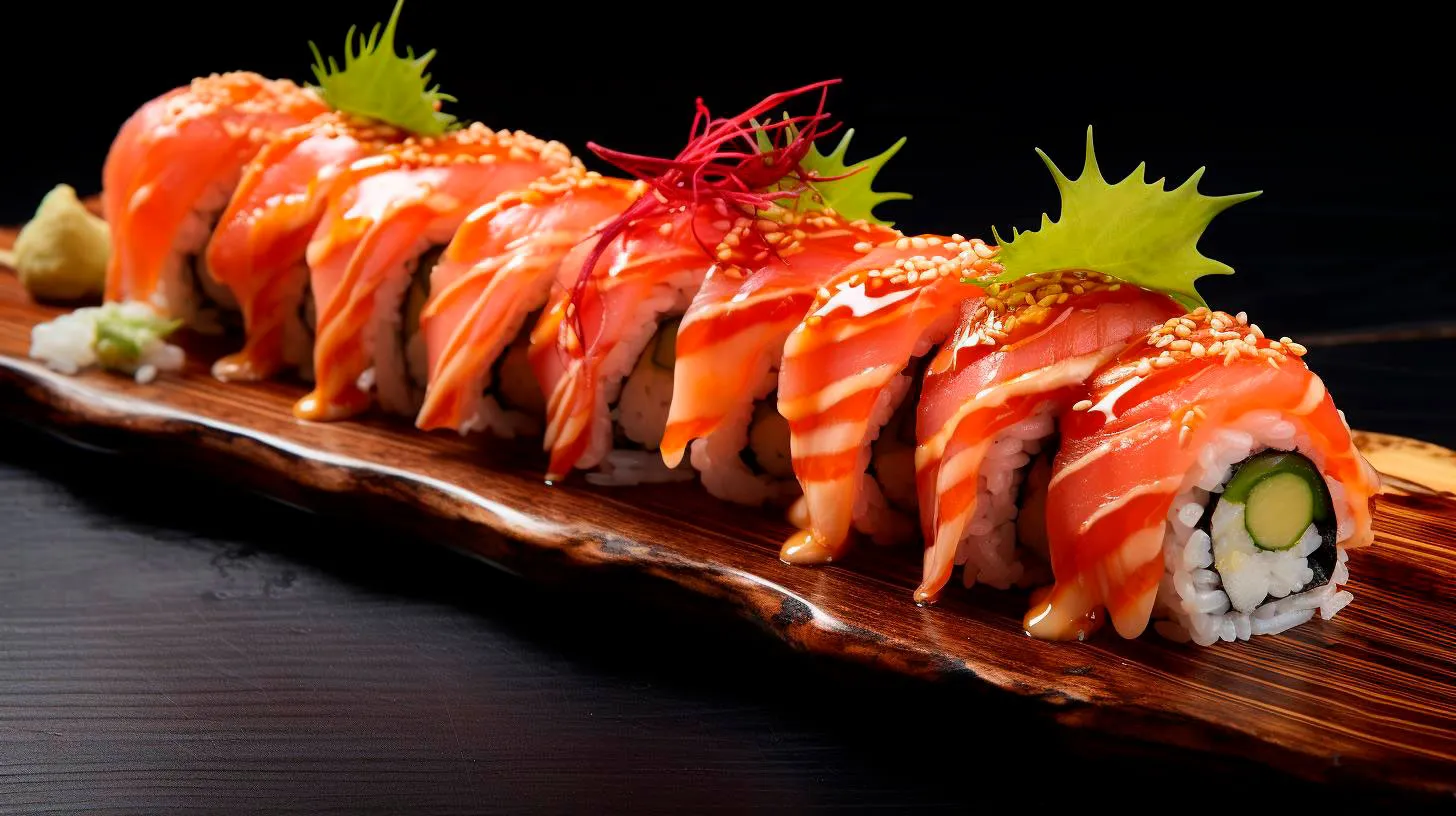Exploring the World of Gluten-Free Sushi: A Comprehensive Guide
In this comprehensive guide, we will explore the world of gluten-free sushi, provide tips for finding safe options, and highlight the advantages of embracing this dietary choice.
The Rise of Gluten-Free Sushi
In recent years, the demand for gluten-free food options has skyrocketed. With an estimated 1 in 100 people worldwide having celiac disease, and many others avoiding gluten due to sensitivity or personal preference, it is no surprise that the sushi industry has adapted to accommodate this dietary need.
-
Safe Sushi Ingredients:
Sushi rice, nori (seaweed), fresh fish, vegetables, and select sauces are typically gluten-free, making them safe options for sushi lovers avoiding gluten.
-
Gluten-Free Soy Sauce:
Traditional soy sauce contains wheat, which makes it unsuitable for gluten-free diets. However, gluten-free soy sauce, made with alternative grains or legumes, is readily available in most grocery stores and sushi restaurants.
-
Innovative Sushi Creations:
Sushi chefs around the world have begun substituting traditional ingredients with creative alternatives to cater to gluten-sensitive patrons. Examples include using cucumber instead of seaweed as a wrap or using gluten-free tempura batter for a crunchy texture.
Finding Gluten-Free Sushi Options
While many sushi restaurants now offer gluten-free selections, it is essential for individuals with a gluten intolerance to educate themselves on how to find safe options. Here are some tips:
-
Read Menus with Caution:
Check for clear indications of gluten-free options on the menu, such as symbols or specific labels. Don’t hesitate to ask the staff for clarification when unsure.
-
Communication is Key:
Inform the sushi chef or server about your dietary restrictions to ensure they understand your needs. They can guide you towards gluten-free choices and offer alternatives for any potential allergens.
-
Look for Dedicated Gluten-Free Sushi Bars:
In larger cities, you may find specialized sushi bars that focus on gluten-free options. These establishments have an increased awareness of gluten-related issues and are dedicated to catering to those needs.
The Advantages of Gluten-Free Sushi
Opting for gluten-free sushi can bring various benefits to your overall well-being and dining experience:
-
Improved Digestion:
For those who are gluten-sensitive, eliminating gluten from their diet can alleviate digestive issues such as bloating, gas, and discomfort.
-
Wider Culinary Exploration:
By embracing gluten-free sushi, you open yourself up to a whole new realm of flavors and ingredients, expanding your culinary horizons.
-
Healthier Ingredients:
Gluten-free sushi is often made with fresher, whole food ingredients such as vegetables, fish, and legumes. This can contribute to a more nutritious meal overall.
Key Takeaways
Gluten-free sushi options have made it easier for individuals with celiac disease or gluten sensitivity to enjoy this beloved Japanese dish. Here are the key takeaways from our comprehensive guide:
- Gluten-free sushi ingredients include sushi rice, nori, fresh fish, and specific sauces.
- Gluten-free soy sauce is widely available as an alternative to traditional soy sauce.
- Sushi chefs have become creative in developing gluten-free options, experimenting with ingredients and textures.
- When seeking gluten-free sushi, read menus carefully, communicate with staff, and consider dedicated gluten-free sushi bars.
- Gluten-free sushi offers advantages such as improved digestion, culinary exploration, and access to healthier ingredients.
Now armed with valuable knowledge about gluten-free sushi, embark on your culinary adventure and savor this Japanese delicacy without compromising your dietary needs. Embrace the world of gluten-free sushi and indulge in a taste experience that caters to everyone.
Expert Tips for Dining Safely with Food Allergies
In this article, we will provide expert tips that will help you dine safely while enjoying a worry-free meal.
1. Do Your Homework
Prior to dining out, it is crucial to do thorough research on the restaurant or food establishment. Check if they have an allergen menu or if they are known for having allergen-friendly options. Many restaurants nowadays make this information readily available on their websites. Reading customer reviews can also provide insight into how well a restaurant handles food allergies.
- Search for restaurants that are known for accommodating food allergies
- Look for allergen menus on their website
- Read customer reviews related to their handling of food allergies
2. Communicate Your Allergies
Once you have chosen a restaurant, it is imperative to communicate your food allergies to the staff. Inform your waiter, manager, or chef about your allergies, and make sure they understand the severity of them. Clear communication is key to avoiding cross-contamination and accidental exposure. Don’t hesitate to ask questions about ingredients, cooking methods, and potential allergen sources in the dishes you are interested in.
- Communicate your allergies to the staff
- Make sure they understand the severity of your allergies
- Ask questions about ingredients and potential allergen sources
3. Be Aware of Cross-Contamination
Cross-contamination is a major concern for individuals with food allergies. It occurs when allergens come into contact with non-allergenic foods, causing allergic reactions. When dining out, be aware of potential sources of cross-contamination, such as shared utensils, cutting boards, fryers, and grills. Ensure that the staff is taking necessary precautions to prevent cross-contamination, such as using separate cooking surfaces and utensils when preparing allergy-safe meals.
- Be aware of potential sources of cross-contamination
- Ensure staff uses separate cooking surfaces and utensils for allergy-safe meals
- Avoid dishes that are at high risk for cross-contamination
4. Carry Emergency Medication
Even with all the precautions taken, it is crucial for individuals with food allergies to carry emergency medication at all times. This typically includes an epinephrine auto-injector, commonly known as an EpiPen. Accidental exposure to allergens can happen despite our best efforts, and quick access to medication can be life-saving.
- Carry emergency medication at all times
- Ensure it is easily accessible in case of accidental exposure
- Inform your dining companions about the location of your emergency medication
5. Choose Simple, Unprocessed Dishes
When dining out with food allergies, it is often safer to choose simple, unprocessed dishes. Avoid complex dishes with numerous ingredients, as they may increase the risk of cross-contamination and make it difficult to identify potential allergens. Opt for dishes where you can clearly understand and verify the ingredients.
- Choose simple, unprocessed dishes
- Avoid complex dishes with numerous ingredients
- Look for dishes with clear and verifiable ingredients
Key Takeaways
Dining out with food allergies can be intimidating, but it doesn’t have to be. By doing your homework, communicating effectively, being cautious of cross-contamination, carrying emergency medication, and choosing wisely, you can enjoy eating out without compromising your safety.
Remember, your health is of utmost importance, and taking necessary precautions will ensure a safer and happier dining experience. Don’t let food allergies limit your culinary adventures; armed with the right knowledge and awareness, you can savor every meal with peace of mind!
Gluten-Free Sushi: A Delicious Alternative for Those with Food Allergies
One such delightful alternative is gluten-free sushi.
Sushi, a traditional Japanese delicacy, typically consists of vinegared rice combined with various ingredients such as raw or cooked seafood, vegetables, and seaweed. While sushi rolls are usually made with soy sauce, which contains gluten, many innovative sushi restaurants now offer gluten-free versions that retain the delicious flavors of traditional sushi. These gluten-free alternatives allow individuals with food allergies or gluten sensitivities to enjoy this popular dish without any concerns.
The Rise of Gluten-Free Sushi
The demand for gluten-free options has grown significantly in recent years, leading to a rise in restaurants incorporating gluten-free alternatives into their menus. This includes sushi restaurants, where chefs are crafting delicious gluten-free versions that cater to a wider range of dietary needs.
Gluten-free sushi rolls are typically made using tamari, a gluten-free soy sauce alternative, or other gluten-free condiments. By substituting traditional soy sauce with gluten-free options, sushi chefs can ensure that their creations are safe for those with gluten sensitivities. Additionally, chefs may use gluten-free ingredients such as rice paper or cucumber wraps instead of nori (seaweed) to make the rolls, further expanding the variety of gluten-free sushi available.
Benefits of Gluten-Free Sushi
Choosing gluten-free sushi has several advantages for individuals with food allergies or sensitivities. Here are some key benefits:
- Variety: Gluten-free sushi opens up a whole new world of flavor combinations and options. Chefs create unique rolls using gluten-free ingredients, allowing individuals to indulge in a diverse range of sushi rolls.
- Safe and Comfortable Dining: Gluten-free sushi ensures a worry-free dining experience for those with gluten sensitivities. By opting for gluten-free rolls, individuals can savor the taste of sushi without concerns about potential allergic reactions.
- Healthier Alternative: Gluten-free sushi often incorporates fresh and nutritious ingredients. From avocado and cucumber to fresh fish and vegetables, gluten-free rolls can be a healthy and tasty choice for sushi lovers.
- Inclusivity: By offering gluten-free sushi options, restaurants promote inclusivity by catering to a wider range of dietary needs. People with gluten sensitivities can join their friends and family in enjoying sushi, fostering a more inclusive dining culture.
Key Takeaways
Gluten-free sushi offers a delectable alternative for those with food allergies, providing them with the opportunity to enjoy this beloved dish without any concerns. Here are the main takeaways:
- Gluten-free sushi is an innovative adaptation of the traditional Japanese delicacy, making it accessible to those with gluten sensitivities.
- Using gluten-free ingredients like tamari, rice paper, or cucumber wraps allows sushi chefs to create safe and delicious alternatives for individuals with food allergies.
- Choosing gluten-free sushi provides several benefits, including a diverse range of flavors, a worry-free dining experience, healthier ingredient options, and a more inclusive dining culture.
If you have gluten sensitivities or food allergies, don’t miss out on the joy of sushi. Seek out sushi restaurants that offer gluten-free options, and embark on a gastronomic adventure full of delectable and safe flavors.
Food Allergies and Sushi: How to Enjoy a Safe and Delicious Meal
In this article, we will explore the world of food allergies and sushi, providing insightful tips to help you enjoy a safe and delicious meal.
Understanding Food Allergies
Food allergies are a common occurrence worldwide, affecting millions of people. An allergic reaction occurs when the immune system mistakenly identifies certain food proteins as harmful. The most common food allergens typically associated with sushi include fish, shellfish, soy, and gluten.
Research and Communication
Before heading out to a sushi restaurant, it is essential to conduct proper research. Check online for menus, customer reviews, or even call the restaurant to inquire about their allergen policies. By communicating your specific requirements, you can ensure that the restaurant staff is aware of your needs. Keep in mind that cross-contamination can occur, so it’s crucial to discuss preventive measures with the restaurant staff.
Choose the Right Sushi
Sushi comes in different varieties, and some options are more suitable for individuals with specific food allergies. Here are some sushi types to consider:
- Sashimi: Slices of raw fish without any rice or soy sauce. Ideal for individuals with soy or gluten allergies.
- Veggie Rolls: Delicious rolls made solely with vegetables. Perfect for individuals with fish or shellfish allergies.
- Tempura: Lightly battered and deep-fried vegetables or seafood. Suitable for those with gluten allergies.
Remember to communicate your allergies and dietary restrictions to the sushi chef or waiter to ensure they understand your needs.
Reading the Label
While dining at a sushi restaurant, it can be challenging to read ingredient labels, but it is still essential to understand the potential allergens present in the sushi dishes. Be cautious of the following ingredients:
- Soy Sauce: Contains gluten, making it unsuitable for those with gluten allergies.
- Fish: Consult the sushi chef about the fish used and any potential cross-contamination risks.
- Shellfish: If you have shellfish allergies, it is important to verify which rolls or dishes might contain shellfish.
By staying informed and vigilant, you can avoid allergen exposure and enjoy your sushi experience to the fullest.
Key Takeaways
Here are some essential tips for individuals with food allergies planning to eat sushi:
- Research restaurants beforehand and communicate your allergies when making a reservation.
- Choose sushi types that suit your specific food allergies, such as sashimi or veggie rolls.
- Discuss your allergies with the sushi chef or waiter, ensuring they understand your needs.
- Be cautious of hidden allergens like soy sauce, fish, or shellfish in sushi dishes.
Remember, your health should never be compromised when it comes to enjoying sushi. By taking the necessary precautions and communicating your needs effectively, you can enjoy a safe and delicious sushi meal.


